Business + Marketing
Keeping Up With the Ever-Changing Social Media Algorithms
June 16, 2017
The photos throughout this story are some of the best-performing images on social media by the photographers who contributed their thoughts here. Partly because of the changes implemented by Facebook and Instagram, these photographers have used audience engagement tracking to their benefit.
Want to become a master of your channels? We asked the pros how they stay on top of Instagram and Facebook to maximize reach and engagement.
The De-Simplifying Of Instagram
Instagram’s triumph is, in part, the result of keeping in step with new trends as they emerge. Starting with Instagram Stories last summer, the social network continually shifts to match the needs of its users, adapting Facebook-like capabilities such as live video, business profiles, album slideshows and a Pinterest-esque functionality in Collections.
Instagram Gallery Sharing
Slideshows allow users to upload up to ten photos or videos in a single post.
Maya Lora uses them to preview a new blog, and she adds a link to the corresponding blog post in her Instagram bio, which gives users a direct path to see the rest of the images. “In the future, I could see myself using [slideshows] more often for wedding collections when I want to post all the new photos at once.”
Jacob Loafman, an Rf 30 Rising Star in 2016, plans to tap slideshows for “first looks” this season, and for his personal work (above), he says, he likes showing four or five photos from a series.
The Limits of Slideshows
• Jose Villa doesn’t use slideshows yet because he prefers to post one great shot instead of several at a time. At least for now, users can only post in square formats and take on one caption and location tag for the entire slideshow.
Audience Insights on Instagram
The ability to make your Instagram account a Business profile lets you include direct contact information within a profile, promote posts and gain insights on followers.
“I have obtained so much information from my insights—followers’ activity, times to post, where my followers are mostly based, how many impressions I’ve accomplished and what content performed best,” Lora says. According to her insights, her followers tend to respond best to weddings and adventurous engagement photos.
For Villa, who views Instagram as his primary photo portfolio, transferring to a Business Account was also a no-brainer. “I can safely say I’ve received dozens of jobs from Instagram,” he says, and allowing people to call or email him directly through his Business profile positively mediated this process. “I love using the Business Account—I would honestly pay for it if it were offered.”
Instagram’s Targeted Ads
Business account users can turn well-performing photos into ads in Instagram. Lora checks her followers’ age demographic and targets her ads accordingly. “I also use my most engaged post as a cover photo [on Facebook] because I know people are loving it,” she says.
The Dependability
Aaron DuRall finds the direct emailing to be just about the only benefit. While some have had success with the analytics, “it has never been very accurate at gauging the best times for peak audience engagement” for the account he shares with his wife and business partner, Whitney. “It seemed to us we typically got lower engagement on the days and times it would list as the best.”
They’re sticking to a consistent posting schedule and turning to the app Iconosquare, which, for a yearly fee, provides them with more insights and metrics on Instagram engagement.
Fostering Mood Boards
Similar to Pinterest, Instagram Collections lets you save and create albums of images from other users, simply by tapping and holding the bookmark icon under a post.
Lora likes to think of the Collections she saves as mood boards for both her clients and herself. “I use Collections as a way to gain and save inspiration for upcoming photo shoots—in-home sessions, weddings, engagements, couples,” she says. “If clients are open to new ideas or don’t know how to put an existing idea into words, Collections can help us brainstorm.”
Book Now
Instagram plans to add direct bookings, an undoubtedly useful feature for photographers and clients, Lora says, who would have a quicker path to get in touch and “don’t have to email you or direct-message you to book you.”
The Stories They Tell
Photographers are using Instagram Stories to share…
1. Tips and Advice
For Jose Villa, who also conducts workshops, Stories is a great teaching tool. He posts a Story at least once a day, using it to provide a behind-the-scenes glimpse of his photo business, and a way to highlight brands with which he collaborates. He’s also done a couple of Live Video sessions, an option with Stories, in response to queries about his lighting and shooting setups. “A lot of people tuned in and asked me questions and were really responsive, which was great,” he says. He appreciates that the Stories disappear, however: “I don’t like to give everything away.”
2. Hobbies with Personality
Jacob Loafman uses Stories to post quirky instructional videos about how to make a cup of hot tea or how to eat an ice cream sandwich, and he’s seen an increase in followers because of it. “My whole motto is to show clients and any follower who I really am,” he says, “which is a silly weirdo that happens to make photographs.”
3. Home Videos
Besides sharing behind-the-scenes insights on shoots and workflow, the DuRalls like to get personal with their Stories: “It’s winter and we’re going ice skating? Well, we’re both terrible ice skaters, but let’s share this video because it shows who we are in all of our dorky glory.” Just for fun.
— Lindsay Comstock
Outsmarting the Facebook Algorithm
As the largest social media network in the world, Facebook commands immense control over who sees your posts. Using a complex algorithm that determines who sees what how often, the company decides what is worthy of being spotlighted, and what gets pushed to the bottom of the newsfeed.
Post It
Facebook ranks users who use the platform consistently higher than those who don’t use it much at all. “You can’t post one great photo a week,” notes Trevor Dayley, a wedding photographer based in Arizona and MagMod’s marketing director. “You have to be posting once or twice every day. Facebook wants to see that you aren’t a one-trick pony.” By responding to comments, you’re also showing Facebook that you’re communicating more, so make sure to write back (building relationships while you’re at it).
Video Sharing Power
Last year, Facebook reported that its users watch 100 million hours of video a day. BuzzSumo, in an analysis of 800 million posts from 2016, found that questions, images and videos were more engaging than any other type of posts, and the ones that were most likely to be shared were videos.
Preferential Treatment
Facebook ranks videos by weighing a number of factors, including whether a user turned on sound, went full screen, turned on high definition or whether the video is live.
Just 30 Seconds of Your Time
Not every photographer is going to be excited about posting longer videos, especially when you’re not a videographer. Dayley recommends starting out by posting 30-second slideshows from a client’s wedding or portrait session—it works for him. “I wouldn’t even use captions, or my logo,” he says. “It’s more effective to make the video look less like marketing and more of a thank you to my clients for letting me shoot their wedding day.”
On Mute
Facebook is rolling out a new feature that will automatically play videos with sound (unless your device is on silent), fading in and out as they’re swiped across a screen. Previously, muted videos were the default, presumably for people watching videos at work or in public places. Users will have the option of disabling this new sound-on feature, so if your video does have dialogue, add subtitles to ensure that users will watch until the end regardless of their audio settings.
Live Videos
Facebook’s research shows that live videos are watched three times longer and get ten times more comments. Virginia photographer and educator Katelyn James concurs—her live videos have been performing best as of late. Try to go live for a few minutes during a wedding or shoot, or even stream a clean edit from a recent shoot.
Note: Facebook defines percent completion as how much of a video is watched in comparison to its length. Additionally, it takes three seconds of watching to count as one video view. Facebook used to apply the same percent completion rule to all videos, no matter the length— effectively favoring shorter videos, considering most users’ attention spans. But Facebook reported making a tweak in favoritism, giving more preference to longer videos with higher completion rates.
Reactions > Likes
“Love,” “haha,” “wow,” “sad” and “angry” rank higher within Facebook’s algorithm than a “like.” (Time to turn up the feelings!)
Three Steps To Authentic Engagement
1 Don’t ask for interaction.
It’s no surprise that users respond better to content they deem authentic rather than content that seems like an ad—and with advertisers getting more clever by the day, that line is perceptibly getting thinner. Interactions have to be organic. Asking for likes, comments or shares is one surefire way to get your content downgraded by Facebook.
2 Ditch the watermark.
Another way to scare off users, Dayley notes, is to add watermarks or warnings on your photographs. “Captions that say don’t crop, don’t change, copyright protected, are very threatening,” he says. “It’s like you’re standing up with you arms crossed, and saying, ‘Don’t touch it.’”
3 Make it educational.
James notes that blatant self-promotion scares off users too. “If we share a blog post about being featured somewhere, we always include some tips or tricks for other photographers to use when they are submitting their work,” she says. “People love giving advice and hearing advice. What people don’t love is hearing someone brag about what they have accomplished. If you took an amazing shot and you want to share it, maybe share some of the backstory of how you created it and why you love it so much.”
—Brienne Walsh
What About Snapchat?
There’s a saying among creative folks that “good artists copy, but great artists steal.” If that’s the case, then Instagram is one of the greats.
Over the past year, the Facebook-owned social network has appropriated one feature after another from Snapchat. And while it’s not yet clear whether this has dealt a mortal blow to the rival (which, as of this writing, has a market cap of $25 billion), Instagram is peeling away photographers who had been using the platform to engage with their fans, clients and followers.
It began with last year’s introduction of Instagram Stories, a feature that lets users post photos and videos that “disappear” after 24 hours. Next came the ability to add silly objects to selfies, tools to draw or write text on images—and this spring, Instagram added geo-filters, the ability to add filters to images that are only visible in certain locations.
Jose Villa found that once Stories debuted, he stopped using Snapchat as much. “I just have much more reach on Instagram,” and it made a lot more sense to consolidate audiences in one place.
Snapchat may have always been an awkward fit for professional photographers. As a platform, it denigrated the value of images as a permanent work of art or expression, instead emphasizing images as merely a transient medium of communication—no more important than an emoji-filled text. With Instagram and Instagram Stories, users gets the best of both with a steady perennial portfolio of photos and flighty experimentation.
It’s a hard combo to beat. Maybe it’s time for a Snapchat Portfolio feature.
—Greg Scoblete
Related: Instagram Tips To Grow Your Following and Your Brand













